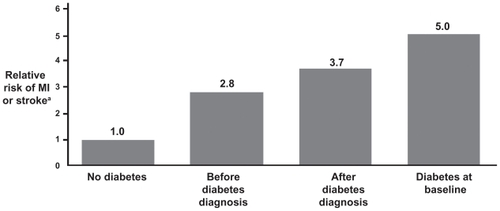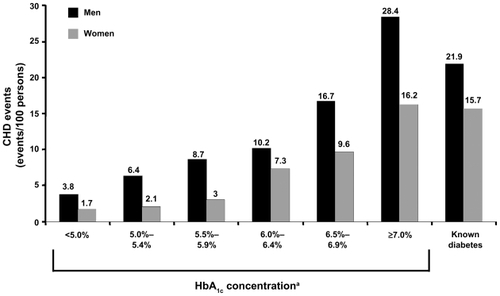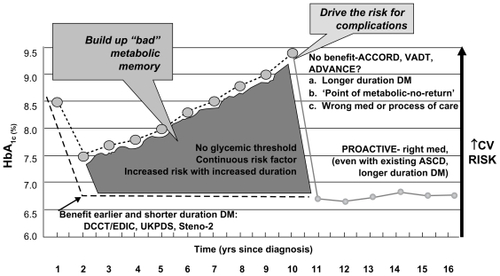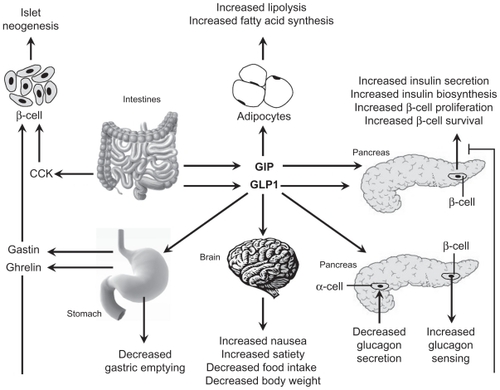Figures & data
Figure 1 The “ticking clock” hypothesis. Glucose abnormalities increase cardiovascular risk even before the diagnosis of diabetes is made. Multivariate relative risks and 95% confidence intervals of myocardial infarction (MI) or stroke according to diabetes status. The Nurses’ Health Study, N = 117,629 women, aged 30–55 years; follow-up 20 years (1976–1996). Adapted with permission from Hu FB, Stampfer MJ, Haffner SM, Solomon CG, Willett WC, Manson JE. Elevated risk of cardiovascular disease prior to clinical diagnosis of type 2 diabetes. Diabetes Care. 2002;25(7):1129–1134.Citation11 Copyright © 2002 American Diabetes Association.

Figure 2 Glycated hemoglobin (HbA1c) and heart disease in type 2 diabetes. HbA1c predicts CHD in type 2 diabetes. Rates for total CHD events by category of HbA1c concentration and known diabetes in 4,462 men and 5,570 women aged 45–79 years. Adapted with permission from Khaw KT, Wareham N, Bingham S, Luben R, Welch A, Day N. Association of hemoglobin A1c with cardiovascular disease and mortality in adults: the European prospective investigation into cancer in Norfolk. Ann Intern Med. 2004;141(6):413–420.Citation12 Copyright © 2004 American College of Physicians.
Abbreviation: CHD, coronary heart disease.

Table 1 Conversion table
Figure 3 Understanding cardiovascular outcome studies in type 2 diabetes mellitus. These data highlight the importance of balancing the benefits and risks of antidiabetes medications when making treatment decisions using agents that minimize the risk of hypoglycemia and weight gain, and possibly lead to weight loss.
Abbreviations: ACCORD, Action to Control Cardiovascular Risk in Diabetes; ADVANCE, Action in Diabetes and Vascular Disease: Preterax and Diamicron MR Controlled Evaluation; ASCD, atherosclerotic cardiovascular disease; CV, cardiovascular; DCCT/EDIC, Diabetes Control and Complications Trial/Epidemiology of Diabetes Interventions and Complications; DM, diabetes mellitus; HbA1c, glycated hemoglobin; PROACTIVE, Prospective Pioglitazone Clinical Trial in Macrovascular Events; UKPDS, United Kingdom Prospective Diabetes Study; VADT, Veterans Affairs Diabetes Trial.

Figure 4 Actions of gastrointestinal hormones on key tissues in glucose homeostasis. Both GIP and GLP-1 promote insulin biosynthesis, insulin secretion, and islet β-cell survival. GLP-1 exerts additional actions, including inhibition of glucagon secretion and gastric emptying, and induction of food intake. GIP has a direct effect on adipocytes coupled to energy storage. In contrast, CCK and gastrin do not regulate plasma glucose levels but could be important for stimulation of islet neogenesis. Reprinted with permission from Girard J. The incretins: from the concept to their use in the treatment of type 2 diabetes. Part A: incretins: concept and physiological functions. Diabetes Metab. 2008;34(6 Pt 1):550–559.Citation39 Copyright © 2008 Elsevier.
Abbreviations: CCK, cholecystokinin; GIP, glucose-dependent insulinotropic polypeptide; GLP-1, glucagon-like peptide-1.

Figure 5 Glucose-stimulated secretion of insulin and potential mechanisms of interference by selected medications. Also, the potential mechanism by which GLP-1 may overcome these hyperglycemic effects. Adapted with permission from Van Raalte DH, Ouwens DM, Diamant M. Novel insights into glucocorticoid-meidated diabetogenic effects: towards expansion of therapeutic options? Eur J Clin Invest. 2009;39(2):81–93.Citation50 Copyright © 2009 John Wiley and Sons.
Abbreviations: AC, adenyl cyclase; ATP, adenosine triphosphate; cAMP, cyclic adenosine monophosphate; GIP, glucose-dependent insulinotropic polypeptide; GK, glucokinase; GLP-1, glucagon-like peptide-1; GLUT2, glucose transporter 2; PKA, protein kinase A; SUR, sulfonylurea receptor; TCA, tricaroboxylic acid (Kreb’s cycle).

Table 2 Perioperative glycemic guidelines used at the University of Pennsylvania